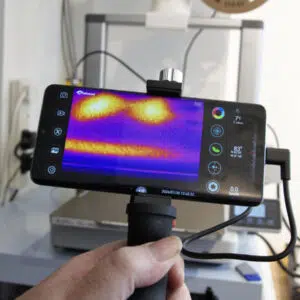

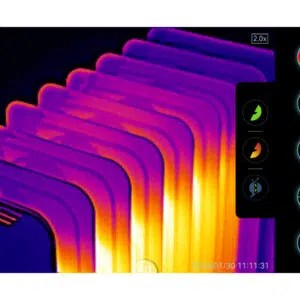
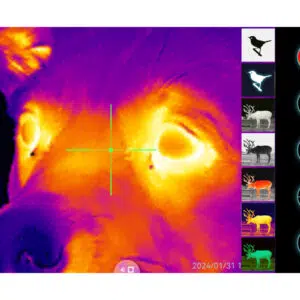

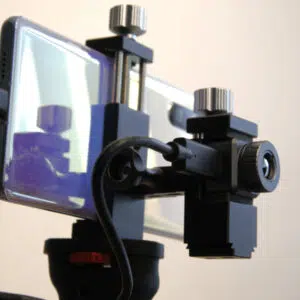
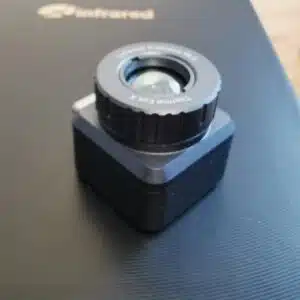
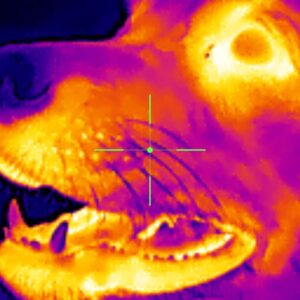
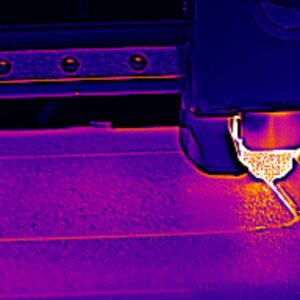

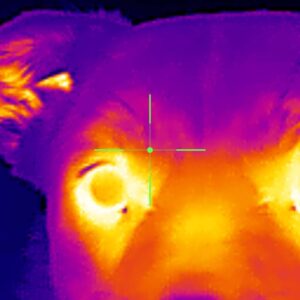

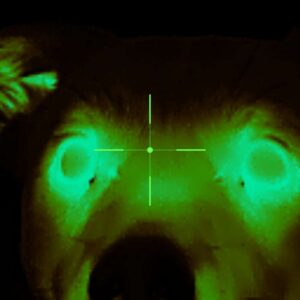


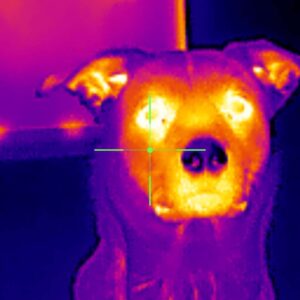



Xinfrared One XH09: 30-second review
Thermal imaging cameras were either low quality or affordable only to those with a business requirement/military budget.
However, this feature is standard on rugged mobile phones, often using the FLIR Lepton sensors.
Where the Xinfrared One XH09 fits into this landscape is that it’s a hardware addon that works with Android or iOS phones using a proprietary sensor for greater fidelity.
On the face of it, this camera seems very similar to the previous Xinfrared P2 Pro, although this design has a variable focus lens, a better resolution sensor and comes with a handle designed to make the capturing of images and video easier.
It can be used simply by plugging it into the phone and running the Thermal Eye X software, but the provided short USB-C cable extension and handle offer a much-improved experience.
In addition to the handle, Xinfrared also makes a housing allowing the One XH09 to be mounted on the scope of a rifle for hunting purposes. While this does appear to unfairly advantage the hunter and might only be relevant to those who live in countries with limited firearm restrictions, it’s an option.
That application hints at how the One XH09 significantly differs from many thermal sensor phones and addons in that the field of view is much narrower. That makes it more useful for outdoor applications, though it still can also be used to find out which heating pipes are warm or if an engine block has a crack.
Overall, the One XH09 is a significant progression for Xinfrared over the P2 Pro and justifies what is an expensive accessory with some excellent features.
Xinfrared One XH09: price and availability
- How much does it cost? $340/£370
- When is it out? It is available now
- Where can you get it? You can get it in most regions from an online reseller such as Amazon.
The Xinfrared One XH09 costs around $40 more than the InfiRay Xinfrared P2 Pro did at launch directly from the maker’s website. It can also be purchased on Amazon for an extra $30 more with next-day delivery.
However, in an exclusive deal that TechRadar has with Xinfrared, the One XH09 is currently offered at 10% off for those that use the discount code “techradar10” on either the Xinfrared site or through Amazon. That brings the price nearer to $300 from the maker.
It could be argued that for this expenditure, buying a phone with thermal imaging is possible, and it is. But, the quality of the sensor on the phone wouldn’t match that of the One XH09, so the comparison isn’t true equivalence.
With this solution’s sophisticated hardware and software, the One XH09 is probably worth its asking price, even without a discount.
- Value score: 5/5
Xinfrared One XH09: Specs
| Model | Xinfrared One XH09 (for Android) |
| Resolution | 256×192 |
| Connection | USB-C |
| Accessories | Camera, USB cable and phone bracket |
| Works on | Android phones 9.0 or above |
| Camera | Focal length 9mm, FOV 19.63°×14.71° |
| Thermal Range | 0C to 100C |
| Thermal Accuracy | 3C (plus or minus) |
| Weight | 18.5g |
| Dimensions | 23mm x 23mm x 23.8mm |
Xinfrared One XH09: design
- Flexible solution
- Metallic construction
- High resolution for thermal camera
The One XH09 camera comes in a small soft pouch with a short cable extension. Our review hardware was made for an Android phone and used a USB-C output and cable, but an Apple iOS-compatible version exists with Lightning connectors on it.
It is possible to connect the camera directly to the phone or tablet, pointing either towards or away, but using it that way isn’t the best solution.
Included with our camera was a smartphone bracket mount that provides a handle to hold both the phone and camera in the best positions. The bottom of the bracket also has a quarter-inch thread, enabling it to be connected to a photography tripod easily.
Our only reservation about this high-quality bracket is that it’s missing an obvious feature. That being a Bluetooth-enabled button. If you could click a button on the handle to take still images or video, then that would be the ideal workflow.
The camera is remarkably small, being only 23mm x 23mm x 23.8mm, with a metal construction that is IP65 rated. It comes with a rubber lens cover and has a manual focus achieved by twisting the front of the lens. To get the best results, some tweaking of the focus ring, and that’s relatively easy when it’s mounted on the phone bracket. It might be much harder when it’s rifle mounted, but we never saw this attachment to access that.
Because the camera can be at different angles, depending on if it is directly attached to the phone or on the bracket, it is possible to define that angle in the Thermal Eye X software, so you are not trying to work with an image that’s upside down.
The One XH09 sensor has a resolution of 256 x 192, which might seem on the low side until you realise that FLIR Lepton 3.5 sensor is only 160 x 120. That’s 49,152 pixels versus 19,200, making the One XH09 sensor more than twice the density.
Design score: 4/5
Xinfrared One XH09: Software
- Simple but powerful
- Still needs some work
The Thermal Eye X software is the latest development of a tool that is used on many of the Xinfrared products, but it has been modified for this camera. It has the ability to capture still images and video of thermal subjects and offers a selection of enhancements to track hot spots and display peak temperatures.
One weakness is that if you ask for numeric temperature overlays, the display tends to become somewhat laggy, even on a powerful smartphone. That suggests the software isn’t using hardware acceleration for those text overlays, and as a result, the fluidity of the capture is undermined.
While some improvements could be made, this software has markedly improved since the P2 Pro was launched, and it does most of what anyone working with thermal imaging might reasonably want. The images can be falsely coloured in a wide range of ways, with many accessible palettes.
It is also possible to define what the surfaces in the shot are (wet, brick, skin, etc.) and also fine control where the temperature reading is sourced within the image.
However, the one feature that it badly needs is a timed capture.
When using the camera bracket with one hand and the focus control with the other, it is impossible to take a shot without a third hand. I tried using voice activation, and that didn’t work; it switched to the conventional camera instead.
A workaround might be a 10-second countdown, allowing the user to initiate a capture and get the framing and focus required. If Xinfrared added something like that or a button on the handle, getting precise shots would be even easier.
- Software score: 4/5
Xinfrared One XH09: camera
- Better resolution
- Supersampling
- Narrow field of view
This sensor is similar to the one previously used in the Xinfrared T2S Plus, with one significant difference. The sensor in that camera runs at 25Hz, whereas the one in the One XH09 runs at double that rate of 50Hz.
Again, this and a smaller FOV of the lens project the One XH09 as being better for outdoor applications than the T2S Plus since any movement is better detected.
A note about power consumption: When you insert the camera into the phone, it starts drawing power, even if the app isn’t running. Therefore, we wouldn’t recommend leaving the camera connected once you’ve done using it.
The one drawback between this camera arrangement and one pre-built into a phone is that they can often enhance captures by mixing them with normal exposures from the conventional camera sensors. As the phone has no idea how the One XH09 is orientated with the phone, this isn’t possible. However, it can show you a PIP (picture-in-picture), which might help you better understand what you are looking at.
Even if this is a good resolution for a thermal sensor, it can still look somewhat blocky. To mitigate this, Xinfrared has added the X3 function to the camera software. What this appears to do is use the increased 50Hz cycle to make multiple captures and then distil a higher-quality image from the extra data.
This effectively boosts the resolution by oversampling, and it works very well.
Where this solution succeeds or fails for most users is the narrow field of view. Because if you are relatively close to the subject, it might be an excessively tight frame. For those further back from their quarry, it will work better and return good results with a little practice.
As for temperature accuracy, it is quoted to be within 3C accuracy by the makers. That’s not a level that would make this usable for medical assessment, so it is best not to assume it is.
Xinfrared One XH09 Camera samples
- Camera score: 4/5
Xinfrared One XH09: Verdict
Depending on the requirement, the One XH09 is easily the best thermal image solution available in its price range. Made specifically for outdoor use, it is perfect for hunting or tracking in low-light conditions.
Where it wouldn’t be ideal is for macro work identifying damaged chips on a motherboard, and for that job, something like the P2 Pro or T2S Plus might be much more suitable.
The included camera bracket is far superior to simply plugging in the camera and allows one hand to be free to make easier focus adjustments.
Critically, this is a higher quality sensor than the FLIR 3.5 Lepton that is in several smartphones, and this solution can work with most modern Android phones or tablets (or iOS devices) with the installation of the software application.
If you require outdoor thermal imaging and already have a premium phone, the One XH09 takes some beating.
Should I buy a Xinfrared One XH09?
| Attributes | Notes | Rating |
|---|---|---|
| Value | A high quality sensor with some useful accessories | 4/5 |
| Design | Clever phone integration and accessories | 4/5 |
| Software | Could be better, but feature packed | 3/5 |
| Camera | Great sensitivity but a narrow field of view | 4/5 |
| Overall | For outdoor work this is a top notch solution | 4/5 |
Buy it if…
Don’t buy it if…
Also consider
Source link



No Comment! Be the first one.